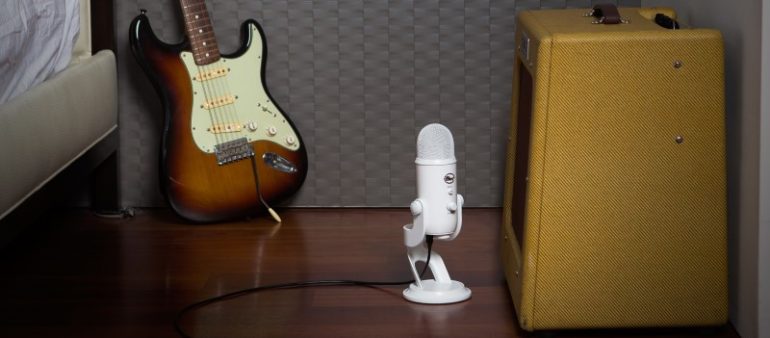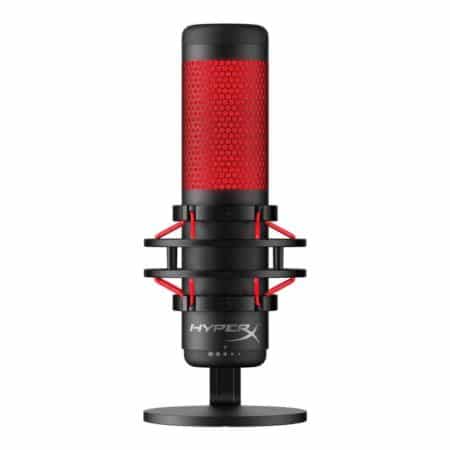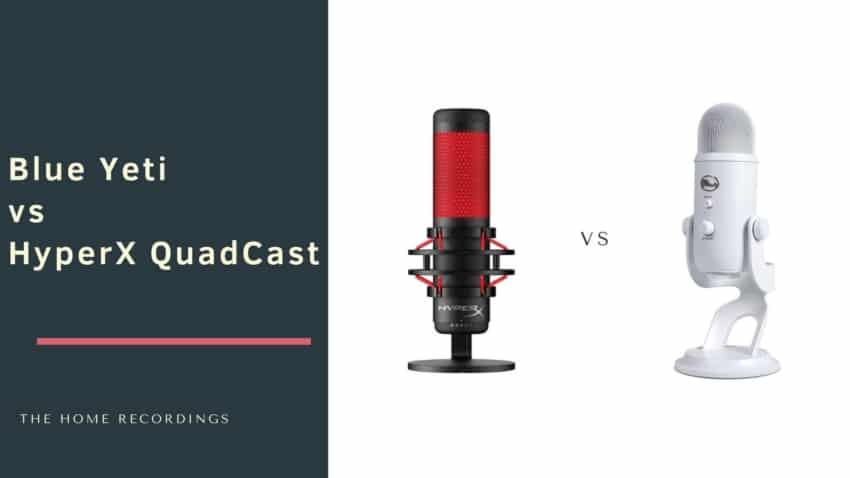Last updated on December 29th, 2023 at 09:58 pm
Since the release of HyperX’s Quadcast USB microphone, many of my readers have asked me about the differences between it and the Blue Yeti as well as my opinion on which one I’d recommend getting.
In this article I will compare both of them and give you my honest opinion on which one I think you should get, as well as recommend you two other microphones that are actually better in almost every way.
Let’s get started!
Blue Yeti vs HyperX Quadcast
Both microphones are almost identical in every way, both in build quality, available features and polar patterns, which are Cardioid, Omni, Stereo, and Bi-directional patterns.
The differences are that the Quadcast comes with a shock mount and a mic-stand mount as well, while the rest of the differences are only cosmetic.
Blue Yeti

Even though Blue is mostly known for their High-end ultra expensive microphones, they also came up with the Blue Yeti, which is an affordable USB microphone, and in fact it’s the best-selling one on the market right now.
The Blue Yeti will work perfectly both on Windows and Mac OS and it’s a plug and play mic, which simply means that once you connect it to your PC, that’s it! It’s ready to be used without having to install any drivers.
The build quality is great, it feels very durable and not flimsy at all; it should last you a very long time if you take care of it.
It features a multitude of pickup patterns like cardioid, omnidirectional, stereo and bidirectional, which makes the Blue Yeti a lot more versatile than most other USB microphones, since usually they only feature a cardioid polar pattern.
You can get it in four colors; Silver, Blackout, Whiteout and Cool Grey.
It is not only a good microphone for podcasters, YouTubers and Voice-over artists, but it’s also pretty good for recording music… emphasis on pretty good.
This microphone also comes with a Gain control, mute button and a zero-latency headphone output, which is on the bottom.
I compared the Blue Yeti to the AT2020 USB and having easy to use knobs is something that one would take for granted, right? But with the AT2020, even though I think that it’s a better-sounding mic, setting the levels is a bit harder.
The reason the Blue Yeti is a great option for recording music is, apart from its good sound quality, that it can record in stereo.
Why is the stereo pattern so useful?
We usually record acoustic guitars, pianos, etc. using two pencil condenser microphones which, when combined, give us some of the best sounding stereo recordings.
While the Blue Yeti won’t give you the exact same results as the two pencil microphones, it may give you a better result than most cardioid microphones out there simply because it’s a stereo recording.
Another plus is that if you already own a cardioid microphone, you can use the omni setting on the Blue Yeti and record with both of them at the same time, using the mid-side technique which is an excellent way of creating a stereo recording.
However, there is one issue with this which is that using two USB microphones simultaneously isn’t that easy.
How does it Perform?
The Blue Yeti is very easy to use and doesn’t require any technical knowledge to be configured; just connect it to your PC and use it, without the need to worry about any drivers or latency.
The sound quality is very good considering the price, plus having four different pickup patterns allows for a lot of versatility, although I don’t really think you will ever use any other pattern except for cardioid.
Do you need to record a bunch of people for a podcast? Or do you need to record and ensemble? Or maybe you just want it to have a conversation over skype…
With all of these pickup patterns you can easily do all of this without any issues.
I liked it especially for voice-related applications but not so much for recording music.
This is because even though the stereo pickup pattern can come in handy when recording something like an acoustic guitar, I just didn’t like the way it sounded as much; It doesn’t sound as bright as I would have hoped.
That’s why I said that it sounds “good” and not “great”.
Don’t get me wrong, it’s a fantastic microphone and it’s super worth the money, plus someone with an untrained ear won’t probably even notice these subtleties.
What comes in the Box?
- The Blue Yeti Microphone
- USB Cable
Features
- Tri-capsule array: three condenser capsules inside
- Multiple pattern selection: cardioid, stereo, omnidirectional and bidirectional
- Gain control, mute button, zero-latency headphone output
- Perfect for podcasting, voiceovers, game streaming, interviews, conference calls and music recording
- Plug ‘n play: Mac and PC compatible
- Desk stand included (already attached to the mic)
Specifications
- Polar Pattern; Cardioid, stereo, omni- and bidirectional
- Frequency Response: 20Hz- 20kHz
- Sample Rate: 48kHz/16-bit
- Max SPL: 120dB
- Weight: 1.2 lbs
If you’re looking for a versatile microphone, then it might be a good idea to go for the Blue Yeti.
Find out more about the Blue Yeti here.
- Blue Yeti: Amazon, Sweetwater.
HyperX Quadcast

So, firstly this microphone is clearly aimed towards gamers who want to stream their gameplay, or just YouTubers in general, because of the way it looks.
Of course, it can be used to do almost anything since it’s a very versatile microphone, but even though I like its appearance, it’s definitely not as professional-looking as the Blue Yeti.
What they do have in common are the pickup patterns, since the HyperX Quadcast also features Cardioid-, Omni-, Bi-directional-, and stereo patterns.
It comes attached to a desk-stand that also has a built-in shock mount, and this is definitely a really nice bonus to have since it will either completely avoid picking up unwanted vibrations coming from the desk, or at least reduce them significantly.
Note: The Blue Yeti doesn’t have this feature, and shock mounts really do help a lot at reducing unwanted noises being picked up.
Of course, it comes with a Gain dial which is situated right at the bottom of the microphone, and it is silky smooth and much more enjoyable to use than the one on the Blue Yeti.
On the back of the microphone you’ll have access to the USB connection and to a headphone jack that lets you do zero-latency monitoring.
Once the microphone is connected and working, it will light up in a really nice red color (I used to think that this was the color of the microphone itself, but it’s actually thanks to the internal lighting).
On the top of the microphone you’ll find a touch-sensitive “Mute” button; When the mic is muter, the background light inside the microphone will turn off.
This is a really nice feature to have for two reasons; Most USB microphones don’t have this option and you need to turn the Gain dial all the way down if you want to mute it, and getting the exact same level afterwards can be tricky.
This way you only need to unmute it and you’re back recording at the exact same level.
The other reason is that since the microphone only lights up when it is recording, you’ll have visual feedback when it’s muted or not.
Now, I mentioned that it comes with four different pickup patterns, and while they all may have their place, you’re probably going to be using the cardioid one the most, especially if you’re doing voice-over, singing, Streaming, etc. since it’s designed to only pick up what is right in front of the mic.
The Omni polar pattern is designed to record everything surrounding it, and if you want to do a podcast and only have this microphone, then this would be the polar pattern of choice.
Lastly, the Stereo and Bi-directional patterns are identical, with the only difference being that the bi-directional picks up sound from the front and back, while Stereo picks up sound from both sides.
If you’re interviewing someone, then Bi-directional is the best one, while if you want to record and acoustic guitar for example, stereo would be best.
How does it perform?
For spoken word, voice over, streaming, etc. I found it to be a good microphone; it sounds full and I needed to do little-to-no editing after the recording was done in order to get a professional sound out of it.
For music, on the other hand, I don’t recommend it.
I recorded my acoustic guitar with it and the Stereo Pattern did work quite well, even though it lacked a bit in the lower end.
With the Cardioid pattern however, it sounded way too boomy for my taste, which is kind of the opposite of what happened with the stereo pattern.
Another issue I found was with the pop filter, which is designed to reduce unwanted plosives when you’re talking;
It is definitely far from the best and if you’re going to be speaking straight into the microphone, then I’d highly recommend purchasing an external pop filter, otherwise get ready to re-record everything multiple times.
One other issue popped up when I mounted it on a regular mic-stand using the adapter; there’s little to no room between the mic and the mic-stand and this creates unnecessary pressure on both the USB- and headphone cables…
So, imagine how long those cables will last? Not to mention the USB and headphone connectors themselves.
Now, one huge pro of this microphone is the “Mute” button on the top, which is something I wish more USB microphones would feature, and also that it comes with a shock mount, so yes, there are some really good things that HyperX did right here.
Lastly, this microphone is marketed towards gamers mostly, so why on earth does it need four polar patterns? You only need a Cardioid one as a gamer/streamer and the cost could’ve been significantly lower if they didn’t include the extra three.
This is definitely a con, but some people may use those extra patterns sometime.
What comes in the Box?
- The HyperX Quadcast Microphone
- USB Cable
- Mic Stand adapter
Features
- Tri-capsule array: three condenser capsules inside
- Multiple pattern selection: cardioid, stereo, omnidirectional and bidirectional
- Gain control, mute button, zero-latency headphone output
- Good for podcasting, voiceovers, game streaming, interviews and conference calls
- Plug ‘n play: Mac and PC compatible
- Desk stand included (already attached to the mic)
- Mic-Stand adapter (may hurt the cables)
Specifications
- Polar Pattern; Cardioid, stereo, omni- and bidirectional
- Frequency Response: 20Hz- 20kHz
- Sample Rate: 48kHz/16-bit
- Sensitivity: -36dB
- Weight: 254g
Find out more about the HyperX Quadcast here.
Which one should you choose?
Now, both microphones are completely identical in every way except for the way they look;
The Quadcast may have a touch mute button while the one on the Blue Yeti is an actual button, but the differences ire negligible and mostly aesthetical.
The issue I have with the Quadcast is that it’s clearly a copy of the Blue Yeti, and it doesn’t even outperform it, plus it’s slightly more expensive.
I think that people, especially gamers, gravitate towards the Quadcast because of the way it looks.
For recording music, I wouldn’t really recommend either of them, but if I had to choose I’d go with the Blue Yeti.
For gaming or streaming, either is fine…
However, there are two other alternatives that beat both of them, and these are the AT2020 USB and the Samson G-Track Pro.
In all honesty, go with any one of those two since they are much better in terms of audio quality.
Conclusion
Even though the Quadcast might look “cooler”, it’s not a better microphone and some people consider it to be a straight copy of the Blue Yeti.
If I absolutely had to choose between one of the two, I’d go with the Blue Yeti, but as I just mentioned, there are other better-sounding alternatives out there that you should consider as well.
Also, even when recording music, not to mention gaming/streaming, we tend to use microphones with a cardioid polar pattern, so why pay extra for those added polar patterns that you’ll never use?
Both of these microphones could be considered a jack of all trades, but also a master of none, and I don’t like that.
I hope this information was useful!
Have a wonderful day!

Stick to your day job. I think you need to take a look at frequency response data for both before you day they are masters of none. I think you also need to take into account their pricing in your assessment which you don’t do. Your going to lead people away from great mics with relatively great sound quality because you’re looking at it from one perspective which is music recording. You should really only review mics specific to this if that’s the purpose of your site, not much with primary focus of streaming and podcasts.